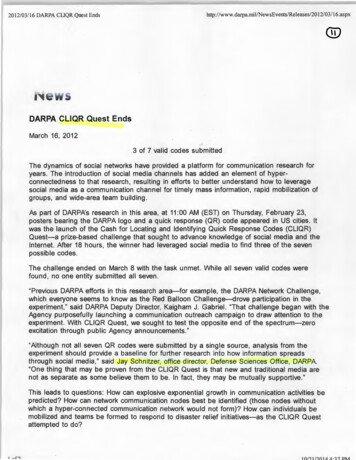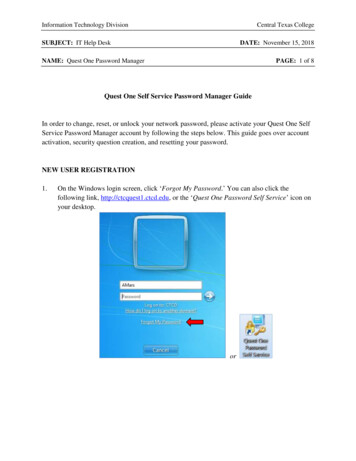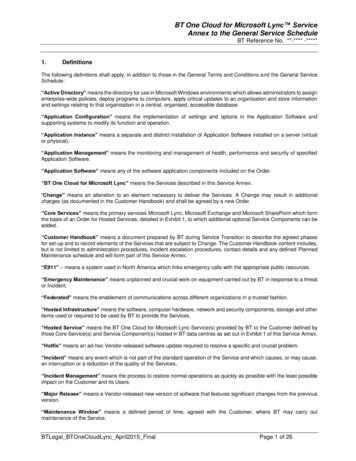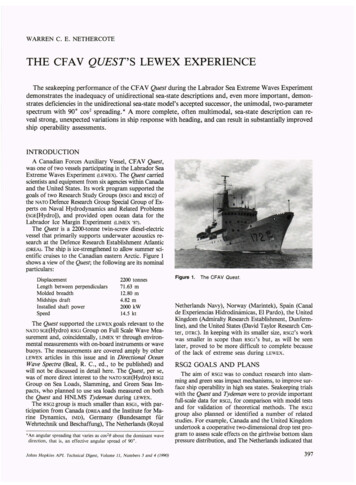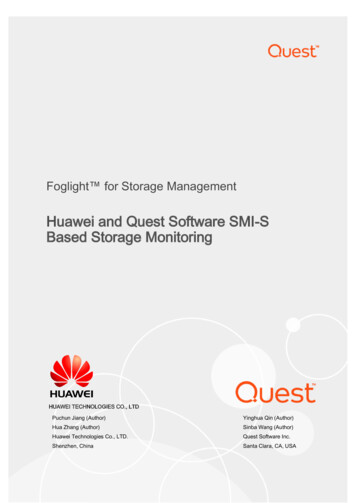
Transcription
Foglight for Storage ManagementHuawei and Quest Software SMI-SBased Storage MonitoringHUAWEI TECHNOLOGIES CO., LTDPuchun Jiang (Author)Yinghua Qin (Author)Hua Zhang (Author)Sinba Wang (Author)Huawei Technologies Co., LTD.Quest Software Inc.Shenzhen, ChinaSanta Clara, CA, USA
2017 Quest Software Inc.ALL RIGHTS RESERVED.THIS WHITE PAPER IS FOR INFORMATIONAL PURPOSES ONLY, AND MAY CONTAIN TYPOGRAPHICAL ERRORS ANDTECHNICAL INACCURACIES. THE CONTENT IS PROVIDED AS IS, WITHOUT EXPRESS OR IMPLIED WARRANTIESOFANY KINDThis guide contains proprietary information protected by copyright. The software described in this guide is furnished under asoftware license or nondisclosure agreement. This software may be used or copied only in accordance with the terms of theapplicable agreement. No part of this guide may be reproduced or transmitted in any form or by any means, electronic ormechanical, including photocopying and recording for any purpose other than the purchaser’s personal use without thewritten permission of Quest Software Inc.The information in this document is provided in connection with Quest Software products. No license, express or implied, byestoppel or otherwise, to any intellectual property right is granted by this document or in connection with the sale of QuestSoftware products. EXCEPT AS SET FORTH IN THE TERMS AND CONDITIONS AS SPECIFIED IN THE LICENSEAGREEMENT FOR THIS PRODUCT, QUEST SOFTWARE ASSUMES NO LIABILITY WHATSOEVER AND DISCLAIMS ANYEXPRESS, IMPLIED OR STATUTORY WARRANTY RELATING TO ITS PRODUCTS INCLUDING, BUT NOT LIMITED TO,THE IMPLIED WARRANTY OF MERCHANTABILITY, FITNESS FOR A PARTICULAR PURPOSE, OR NON-INFRINGEMENT.IN NO EVENT SHALL QUEST SOFTWARE BE LIABLE FOR ANY DIRECT, INDIRECT, CONSEQUENTIAL, PUNITIVE,SPECIAL OR INCIDENTAL DAMAGES (INCLUDING, WITHOUT LIMITATION, DAMAGES FOR LOSS OF PROFITS,BUSINESS INTERRUPTION OR LOSS OF INFORMATION) ARISING OUT OF THE USE OR INABILITY TO USE THISDOCUMENT, EVEN IF QUEST SOFTWARE HAS BEEN ADVISED OF THE POSSIBILITY OF SUCH DAMAGES. QuestSoftware makes no representations or warranties with respect to the accuracy or completeness of the contents of thisdocument and reserves the right to make changes to specifications and product descriptions at any time without notice. QuestSoftware does not make any commitment to update the information contained in this document.If you have any questions regarding your potential use of this material, contact:Quest Software Inc.Attn: LEGAL Dept4 Polaris WayAliso Viejo, CA 92656Refer to our Web site (https://www.quest.com) for regional and international office information.PatentsQuest Software is proud of our advanced technology. Patents and pending patents may apply to this product. For the mostcurrent information about applicable patents for this product, please visit our website at https://www.quest.com/legal .TrademarksQuest, the Quest logo, and Join the Innovation are trademarks and registered trademarks of Quest Software Inc. For acomplete list of Quest marks, visit aspx. All other trademarks andregistered trademarks are property of their respective owners.
Copyright Huawei Technologies Co., Ltd. 2017. All rights reserved.No part of this document may be reproduced or transmitted in any form or by any means without prior writtenconsent of Huawei Technologies Co., Ltd.Trademarks and Permissionsand other Huawei trademarks are trademarks of Huawei Technologies Co., Ltd.All other trademarks and trade names mentioned in this document are the property of their respectiveholders.NoticeThe purchased products, services and features are stipulated by the contract made between Huawei andthe customer. All or part of the products, services and features described in this document may not be withinthe purchase scope or the usage scope. Unless otherwise specified in the contract, all statements,information, and recommendations in this document are provided "AS IS" without warranties, guarantees orrepresentations of any kind, either express or implied.The information in this document is subject to change without notice. Every effort has been made in thepreparation of this document to ensure accuracy of the contents, but all statements, information, andrecommendations in this document do not constitute a warranty of any kind, express or implied.Huawei Technologies Co., Ltd.Address:Huawei Industrial BaseBantian, LonggangShenzhen 518129People's Republic of uawei.com
ContentsIntroduction . 6Purpose . 6Intended Audience . 6Overview . 6What is SMI-S . 8What type of data could be collected with SMI-S . 9Huawei storage product and SMI-S support . 11Application scenario .11Supported profiles and sub-profiles .11Conventions .12Supported environments .13Obtaining software packages .13Installing SMI-S provider .14Uninstalling SMI-S Provider .14Managing the SMI-S Provider Service .15Starting the SMI-S Provider Service .15Stopping the SMI-S Provider Service .16Restarting the SMI-S Provider Service .16Managing Unified Storage Devices .16Adding a Device .16Deleting a Device .17List Device .17Enabling/Disabling HTTP for Connection .18Enabling/Disabling HTTPS for Connection .18Changing the HTTP Port .18Changing the HTTPS Port .19Foglight for Virtualization and Storage Management . 20Monitoring approach . 22
Storage metrics . 24Root cause diagnostic . 28Summary . 29[Heading 1] Appendix . 30
1IntroductionPurposeHuawei Storage and Quest Software Foglight have a joined effort on the SMI-S based storage devicesperformance monitoring. A SMI-S based monitoring on a series of Huawei storage devices have been developedand verified on Foglight for Virtualization Storage Management platform.As part of this joined effort, this document describes the SMI-S storage standard, the procedure for installing andconfiguring Huawei storage SMI-S, and the steps of monitoring SMI-S storage devices using Foglight forVirtualization and Storage Management system, and the procedure for implementing device surveillance.Intended AudienceThis document is intended for: Storage device administrator, datacenter operator who need to monitor the storage devices performanceand keep the SLA of infrastructure performance. ISV (Independent Software Vendor) software development engineers who are creating interoperabilitybetween system like Foglight and Huawei storage software. SMI standard members of SNIA who are looking for practical examples of SMI adoptions.OverviewFoglight for Virtualization and Foglight for Storage Management (FSM) are enterprise software products fromQuest Software, whose purpose is solving complex problems with simple solutions. FSM will help to detect,diagnose and resolve potential issues from the application through the virtualization layer to the physical diskspindle, ensuring optimal virtual machine performance and availability.Foglight for Storage Management - Huawei and Quest Software SMI-S Based Storage MonitoringIntroduction6
The Foglight for Huawei storage SMI-S monitoring plugin is installed in the FSM system. After the installation,the FSM can manage Huawei devices - collecting, persisting, and analyzing the system information, LUNs,Pools, controllers and Disks of device components under surveillance.The interoperability is created based on SMI-S standard which owned by industry consortium SNIA, andsupported by a list of vendors and consumers.Foglight for Storage Management - Huawei and Quest Software SMI-S Based Storage MonitoringIntroduction7
2What is SMI-SThe SMI-S, developed by the SMI organization of the SNIA, is an open standard used to manage storagenetworks of multiple vendors. The SMI-S defines a set of secure and reliable interfaces that help the storagemanagement system identify, classify, and monitor physical and logical resources in a storage area network(SAN).Based on the existing technical standards, the SMI-S covers: Common information model (CIM) - The CIM is developed by a distributed management task force(DMTF) to describe concept models of data. The CIM uses a layered object-oriented system structure tomodel for managed resources. Devices and components can thus be described in an object-orientedmanner. Web-based enterprise management (WBEM) - The WBEM is an enterprise-class management systemstructure developed by a DMTF. The WBEM assembles management protocols and standard Internettechnologies for unified management in a distributed operating environment, improving data exchangecapabilities across technologies and platforms. Service location protocol (SLP) - The SLP is used to discover the SMI-S server and its functions in astorage network environment.Figure 2-1 SMI-S Architecture [2]As an open standard, the SMI-S expands general-purpose capabilities of the CIM, WBEM, and SLP to achieveinteroperability in a storage network environment. For example, the WBEM provides security, resource lockmanagement, and event notification.Foglight for Storage Management - Huawei and Quest Software SMI-S Based Storage MonitoringWhat is SMI-S8
3What type of data could be collectedwith SMI-SSMI-S defines a method for the interoperable management of a heterogeneous Storage Area Network (SAN),and describes the information available to a WBEM Client from an SMI-S compliant CIM Server and an objectoriented, XML-based, messaging-based interface designed to support the specific requirements of managingdevices in and through SANs. This following provides an overview of the functionality matrix approach fordescribing the management functionality provided by the SMI-S.Table 3-1: Functionality matrixThe lowest level of the multi-level model of networked storage management functionality applies to managing thebasic physical aspects of the elements found in a networked storage environment, and the upper levels areinvolved with managing the different logical levels supported by these managed elements. Each level in thismodel depends upon the lower levels being in place.Shown in top-down order, the functionality levels are: (Level 5) Application Level Functionality, (Level 4) File/Record Level Functionality, (Level 3) Block Level Functionality, (Level 2) Connectivity Level Functionality, (Level 1) Device Level Functionality.Managed physical elements in a networked storage environment shall support Level 1 functionality, and maysupport additional functionality levels as well, depending upon the logical capabilities of the managed physicalelement. The functionality supported by a managed element will normally involve a contiguous set of levels in thisFoglight for Storage Management - Huawei and Quest Software SMI-S Based Storage MonitoringWhat type of data could be collected with SMI-S9
model. If a managed physical element supports functionality for a particular upper level, then it will also supportfunctionality for each level between that level and Level 1.For more information about the SMI-S, please get the detail information from the SNIA.Foglight for Storage Management - Huawei and Quest Software SMI-S Based Storage MonitoringWhat type of data could be collected with SMI-S10
4Huawei storage product and SMI-SsupportApplication scenarioeSDK SMI-S Provider enables third-party storage management software to manage Huawei unified storage as anetwork element (NE). Figure 4-1shows the application scenario.Figure 4-1: Application scenarioSupported profiles and sub-profilesTable 4-1 lists the supported features of eSDK SMI-S Provider.Foglight for Storage Management - Huawei and Quest Software SMI-S Based Storage MonitoringHuawei storage product and SMI-S support11
Table 4-1: Supported featuresItemDescriptionSupported ProfilesSupported subprofiles and packages Array Server Block Services Copy Services Disk Drive Lite FC Target Ports iSCSI Target Ports Software Masking and Mapping Group Masking and Mapping Multiple Computer System Physical Package Job Control Replication Services Automated Storage Tiering Indication Block Server PerformanceConventionsTable 4-2 describes the conventions that you must follow when using eSDK SMI-S Provider.Table 4-2: ConventionsItemConventionNamespacesSupported SMI-S versionProtocols and ports CIM Interop namespace: interop Managed resource namespace: root/huaweiSMI-S 1.6 HTTPS, port 5989 HTTP, port 5988Foglight for Storage Management - Huawei and Quest Software SMI-S Based Storage MonitoringHuawei storage product and SMI-S support12
Supported environmentsTable 4-3 lists the Huawei storage device models and versions supported by SMI-S Provider.Table 4-3: Suppoted device models and versionsDevicesVersionOceanStor 18500v3/18800v3V300R003OceanStor V300R006OceanStor 2200V3/2600V3V300R005V300R006OceanStor Dorado 5000v3/6000v3V300R001Table 4-4 describes the operating environment required by SMI-S Provider.Table 4-4: Operating environment required by SMI-S ProviderConfigurationRequirementCPU2 x Xeon dual-core 1.6 GHz or higherFree disk space1 GB or higherOperating systemEither of the following: SUSE Linux Enterprise Server, version 11with SP1 (64-bit) Microsoft Windows Server 2008 R2 Microsoft Windows Server 2012 R2Obtaining software packagesBefore installing and configuring SMI-S Provider, obtain the software packages.Foglight for Storage Management - Huawei and Quest Software SMI-S Based Storage MonitoringHuawei storage product and SMI-S support13
Software packageDescriptionDownload patheSDK Storage SMI-SMI-S Provider installationAccessS SAN X.X.XX Linux.tgzpackage for loadeSDK Storage SMI-SMI-S Provider installationS SAN X.X.XX Windows.zippackage for Windowsand choose IT Storage Tools and Platform eSDK Storage Plugins. Then download desiredsoftware packages.Installing SMI-S providerTask descriptionInstall SMI-S Provider on a third-party Windows server.Procedure1Log in to the SMI-S Provider server as an operating system administrator.2Copy the installation package to the installation path, such as C:\Huawei\eSDK, and decompress thepackage.3Run the following commands on the command-line interface (CLI) command console to install the SMI-SProvider service:C:\Users\Administrator cd ider install.batPegasus installed as a Windows serviceService Location Protocol installed.SLP Info Reg Agent service installed.C:\Huawei\eSDK\smisprovider ----EndUninstalling SMI-S ProviderBefore you use SMI-S Provider of the latest version, you must uninstall SMI-S Provider in the system.Foglight for Storage Management - Huawei and Quest Software SMI-S Based Storage MonitoringHuawei storage product and SMI-S support14
Procedure1Log in to the SMI-S Provider server as an operating system administrator.2Run the following commands on the CLI command console:C:\Users\Administrator cd ider uninstall.bat----EndManaging the SMI-S Provider ServiceStarting the SMI-S Provider Service1Log in to the SMI-S Provider server as an operating system administrator.2Run the following commands on the CLI command console to install the SMI-S Provider service:C:\Users\Administrator cd ider start smis svc.bat Start SMI-S Provider Option Http Option12cDescriptionenable Httpdisable Httpcontinue with current optionCURRENT OPTION: Http disabled.Make a choice or type q to quit: [1,2,C,Q]? 2 HTTP options: Choose 1, 2, C or Q. starting smis service with disableHttpcimserver was started successfully.C:\Huawei\eSDK\smisprovider NOTE: Explanations of the HTTP options: 1: Enables HTTP. 2: Enables HTTPS. C: Uses the current configurations. Q: Exits.----EndFoglight for Storage Management - Huawei and Quest Software SMI-S Based Storage MonitoringHuawei storage product and SMI-S support15
Stopping the SMI-S Provider ServiceAs an operating system administrator, run the following commands on the CLI command console to stop the SMIS Provider service.C:\Users\Administrator cd ider stop smis svc.bat Stopping SMI-S Provider, please wait. cimserver was stopped successfully.C:\Huawei\eSDK\smisprovider Restarting the SMI-S Provider ServiceTo restart the current SMI-S Provider service, run stop smis svc.bat and start smis svc.bat one byone.Managing Unified Storage DevicesAdding a DeviceBy performing the following steps, you can use the SMI-S Provider service to add one or more Huawei unifiedstorage devices.1Log in to the SMI-S Provider server as an operating system administrator.2Run the following commands on the CLI command console.C:\Huawei\eSDK\smisprovider smistool.exeEnter UserName:smis adminEnter Password:Admin@12 Type the password of the SMI-S Provider usersmis admin. Login OKSmis add deviceEnter Device IP list:172.22.0.6 Type the IP address list of Huawei unifiedstorage devices in the IPv4 or IPv6 format. If a single device has multiple IPaddresses, separate them with commas (,). Enter Device Port:8088 Type the port numbers of Huawei unified storagedevices. 12345NAS Head N8KArray NexV1Array NexV2ARRAY HVS SVPNAS SC OSTOR9000Foglight for Storage Management - Huawei and Quest Software SMI-S Based Storage MonitoringHuawei storage product and SMI-S support16
Please Select Device Type [1-5]:3 Currently, only 3 Array NexV2 issupported. Enter Device UserName:admin Type the management account of Huawei unifiedstorage. Enter Device Password: Type the management account password of Huawei unifiedstorage. 0 Local User1 LDAP User4 Machine to Machine UserPlease Select Scope[0,1,4]:0 Select the User Model Add device successSmis quitC:\Huawei\eSDK\smisprovider ----EndDeleting a DeviceYou can perform the following steps to remove a Huawei unified storage device from the SMI-S Provider.1Log in to the SMI-S Provider server as an operating system administrator.2Run the following commands on the CLI command console.C:\Huawei\eSDK\smisprovider smistool.exeEnter UserName:smis adminEnter Password:Admin@12 Type the password of the SMI-S Provider user smis admin. Login OKSmis delete deviceEnter Device IP list:172.22.0.6 Type the IP address list of Huawei unified storagedevices in the IPv4 or IPv6 format. If a single device has multiple IP addresses,separate them with commas (,). Delete device successSmis quitC:\Huawei\eSDK\smisprovider ----EndList DeviceYou can perform the following steps list all the Huawei unified storage device in the SMI-S Provider.1Log in to the SMI-S Provider server as an operating system administrator.2Run the following commands on the CLI command console.C:\Huawei\eSDK\smisprovider smistool.exeEnter UserName:smis adminEnter Password:Admin@12 Type the password of the SMI-S Provider user smis admin. Login OKSmis list device// path Huawei SystemRegistrationData.Addresses "172.22.0.6"instance of Huawei SystemRegistrationDataFoglight for Storage Management - Huawei and Quest Software SMI-S Based Storage MonitoringHuawei storage product and SMI-S support17
{Addresses "172.22.0.6";PortNumber 8088;UserName "admin";Password "******";AuthScope 0;ComMechanism "REST";DeviceType 3;SerialNumber "2102350BSJ10EC000002";};Smis quitC:\Huawei\eSDK\smisprovider ----EndEnabling/Disabling HTTP for ConnectionSMI-S Provider disables HTTP for connection by default. Because HTTP is a non-security connection protocol,you are advised to use HTTPS.To enable/disable HTTP for connection, perform the following steps:1Log in to the SMI-S Provider server as an operating system administrator.2Use the CLI command console to go to the bin directory, and run the following commands:cimconfig -s enableHttpConnection true –p Enables HTTP for connection. cimconfig -s enableHttpConnection false –p Disables HTTP for connection. 3Restart the SMI-S Provider service.Enabling/Disabling HTTPS for ConnectionSMI-S Provider enables HTTPS by default. You are advised to maintain the default configuration.To enable/disable HTTPS for connection, perform the following steps:1Log in to the SMI-S Provider server as an operating system administrator.2Use the CLI command console to go to the bin directory, and run the following commands:cimconfig -s enableHttpConnection true –p Enables HTTPS for connection. cimconfig -s enableHttpConnection false –p Disables HTTPS for connection. 3Restart the SMI-S Provider service.Changing the HTTP PortThe HTTP port is 5988 by default. You can change it based on actual needs.1Log in to the SMI-S Provider server as an operating system administrator.Foglight for Storage Management - Huawei and Quest Software SMI-S Based Storage MonitoringHuawei storage product and SMI-S support18
2Use the CLI command console to go to the bin directory, and perform the following command:cimconfig -s httpPort New port –p3Restart the SMI-S Provider service.Changing the HTTPS PortThe HTTPS port is 5989 by default. You can change it based on actual needs.1Log in to the SMI-S Provider server as an operating system administrator.2Use the CLI command console to go to the bin directory, and perform the following command:cimconfig -s httpsPort New port –p3Restart the SMI-S Provider service.For the entire configuration about the smi-s provider, please refer the official document fromhttp://support.huawei.com.Foglight for Storage Management - Huawei and Quest Software SMI-S Based Storage MonitoringHuawei storage product and SMI-S support19
5Foglight for Virtualization andStorage ManagementFoglight for Virtualization, Enterprise Edition and Foglight for Storage Management are infrastructuremonitoring products from Quest Software.Foglight for Storage Management provides complete monitoring of virtual storage environments, providingperformance and capacity management metrics. It is designed for customers requiring storage monitoringfunctionality, but not full-fledged virtualization environment monitoring functionality.Figure 5-1: Figure 5-1 Foglight for Virtualization and Storage Management Virtual Machine SAN Topology.Foglight for Storage Management monitors virtual environments, providing performance and capacitymanagement metrics to assist you in: Improving management of virtual environments from host to storage. Gaining the information required to optimize storage performance associated with your virtual serverenvironment.Foglight for Storage Management - Huawei and Quest Software SMI-S Based Storage MonitoringFoglight for Virtualization and Storage Management20
Ensuring service level agreements are met. Maintaining high levels of customer satisfaction. Avoiding the loss of cost savings already achieved with virtualization.Foglight for Storage Managementgathers extensive performance metricsand presents that data in a graphicalinterface using architectural diagrams,graphs, alerts, and drill-down screens toquickly identify virtual and physicalstorage problems. It fully supportsVMware (vCenter and vSphere) andHyper-V environments, allowing you tobrowse through your virtualinfrastructure to identify storageperformance, capacity or topologyissues.Foglight for Storage Management isbuilt on Foglight , which provides the following components: Management Server: The Management Server receives information from agents, stores and processesdata, and makes it available in the browser interface. Agent Manager: The Agent Manager is a middleware application that hosts agents, manages agentlifecycle (such as start, stop, and restart), manages the connection to the Management Server, andprovides centralized services to agents. Database Repository: The database where data from all sources is collected and aggregated for displayin the browser interface. Browser Interface: The interface you use to view data collected from your monitored environment and toinvestigate issues. You also use it to configure Foglight for Storage Management and performadministrative tasks.For more information, see “Components” in the Foglight for Storage Management Getting Started online help.Foglight for Storage Management - Huawei and Quest Software SMI-S Based Storage MonitoringFoglight for Virtualization and Storage Management21
6Monitoring approachDuring this procedure, you configure the agent to use SMI-S to collect from the Array Management Host thatmonitors the arrays.To configure an agent to monitor the storage device:1On the navigation panel, under Dashboards, click the Administration tab.2Click the Agents tab, then the Agent Status tab3Click Deploy Agent Package.4The Storage Device Setup Wizard opens. Each of the following steps corresponds to one page in thewizard. Use the Next and Back buttons to navigate between pages.aOn the Select Host Selector page, select the Host to host this agent.bOn the Select Agent Packages page, select SMISStorageAgent.cOn the Agent Configuration Summary page, review the agent configuration. You can go back andmake corrections, if necessary.dClick Finish.5Click Create Agent to open in the wizard6The Storage Device Setup Wizard opens. Each of the following steps corresponds to one page in thewizard. Use the Next and Back buttons to navigate between pages.aOn the Select Host Selector page, select the Host to host this agent.bOn the Select Agent Type and Instance page, select SMISStorageAgent.cOn the Agent Configuration Summary page, review the agent configuration. You can go back andmake corrections, if necessary.dClick Finish.7Select the Agent to configure, click Edit Properties.8Click Modify the private properties for this agent.9Edit the User-defined Properties Host: ip of the SMI-S,default 127.0.0.1 Port: port of the SMI-S, default 5989 Username: the user of the SMI-S, default is smis adminFoglight for Storage Management - Huawei and Quest Software SMI-S Based Storage MonitoringMonitoring approach22
Password: the password of the SMI-S, default is Admin@1210 Click Save.11 Select the Agent that you want to activate12 Click Activate.Foglight for Storage Management - Huawei and Quest Software SMI-S Based Storage MonitoringMonitoring approach23
7Storage metricsThe SMISStorage Agent provide the following metrics collection to support the Huawei Storage Array.ItemMetricSummaryProduct nameExampleDevice IDVendorTotal Disk CapacityModelRelated InventoryResource utilizationFoglight for Storage Management - Huawei and Quest Software SMI-S Based Storage MonitoringStorage metrics24
ItemMetricControllers-ControllersPorts ExampleHighest DataRate MostOperations Status State Date Rate Ops Rate Latency Fc Port Status IP port StatusPort FC PortsUtilizationDistributionPools Status Physical State Data Rate Ops RateOps RateData RateStatusPhysical StateTota
Huawei and Quest Software SMI-S Based Storage Monitoring HUAWEI TECHNOLOGIES CO., LTD Puchun Jiang (Author) Hua Zhang (Author) Huawei Technologies Co., LTD. Shenzhen, China Yinghua Qin (Author) Sinba Wang (Author) Quest Software Inc. Santa Clara, CA, USA

